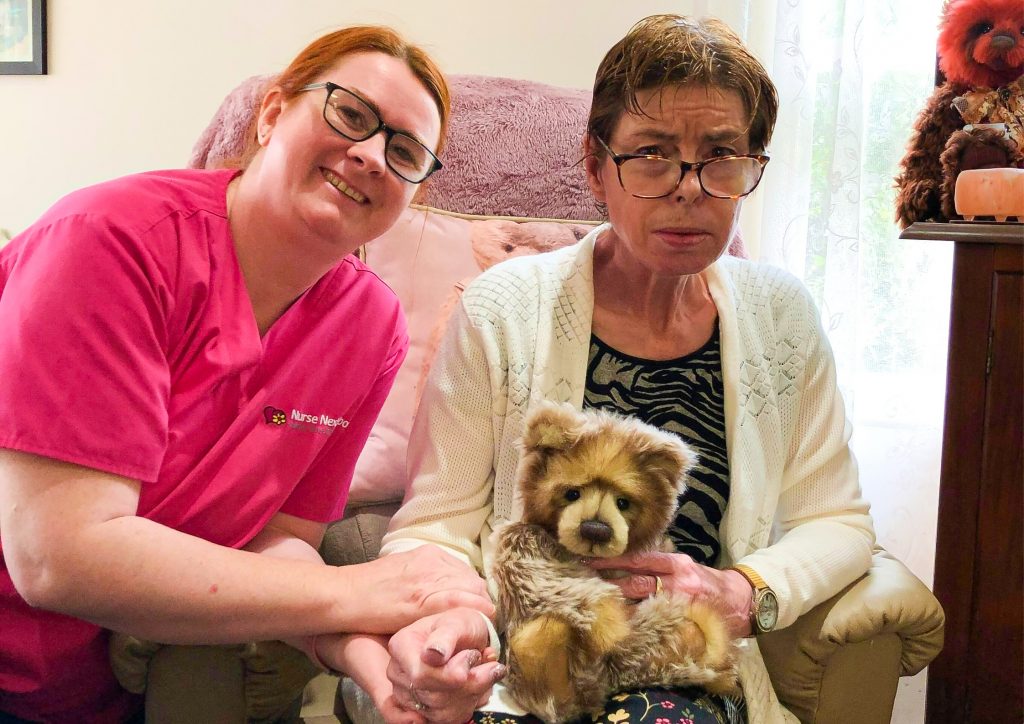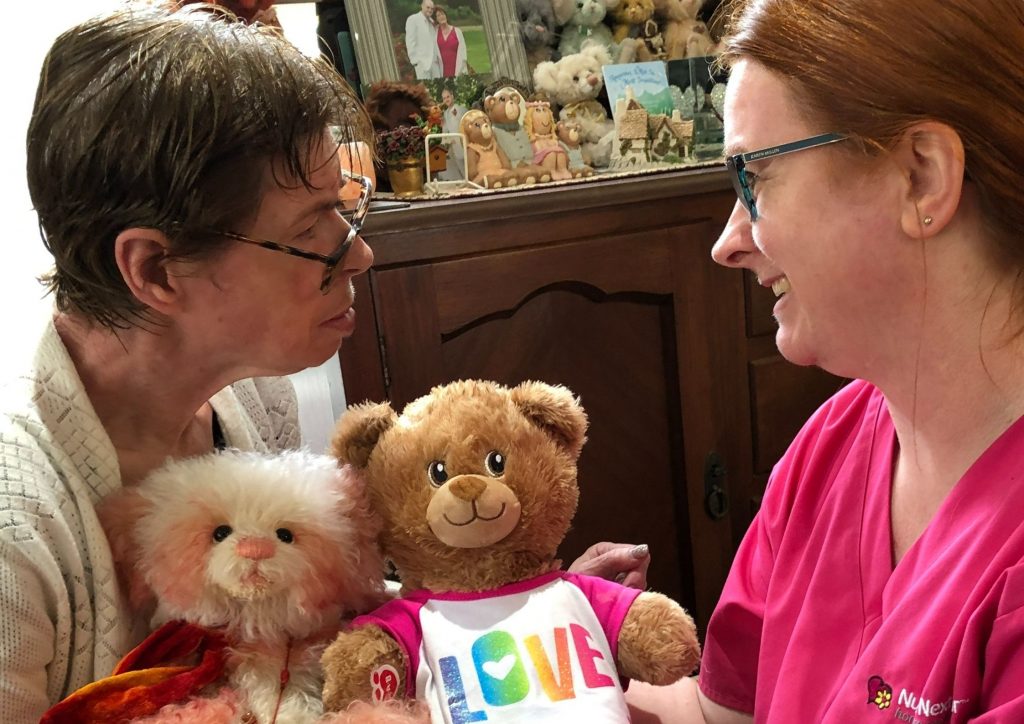What’s Life Like With A Feeding Tube?
“Tube feeding is simply another way of eating, and for some people, it is because of tube feeding that they are still alive.”
Choosing to Live with a Feeding Tube
This week, in support of ausEE Inc., the National charity for eosinophilic gastrointestinal disorders, and Australia’s Feeding Tube Awareness Week, we’re raising awareness about life with a PEG (Percutaneous Endoscopic Gastrostomy tube) most often referred to as a feeding tube.
The decision to live with a feeding tube is based on more than just medical advice from healthcare providers, it is also a personal choice made by the client in order to improve their quality of life, maintain adequate nutrition and continue to live independently in the comfort of their own home.
At Nurse Next Door several of our clients require a feeding tube and – Helen, an award-winning teddy bear maker and master quilter – was happy to share her story. She answering some of the questions about her life with a feeding tube and what her life was like at home.
Understanding Percutaneous Endoscopic Gastrostomy (PEG)
PEG is a procedure in which a flexible feeding tube is placed through the abdominal wall and into the stomach to allow nutrition, fluids and/or medications to be put directly into the stomach to ensure that an individual continues to maintain optimal health.
PEG however, is not always required if the need to use a feeding tube arises. The type of feeding tube used will depend on what the root cause is, some can be temporary only lasting a couple of weeks, while others can be used for months, years or even a lifetime:
Long Term Feeding Tubes
- Gastric tube (G tubes): offers direct access to the stomach through a surgical incision in the left upper side of the abdomen. It allows for food, fluids, and medication to be given without swallowing.
- Jejunostomy tube (J tubes): Are placed lower than the G tube so that the tube ends in the middle third of the small intestine, known as the jejunum. It tends to be smaller than the G tube, so only thin liquids and powdered drugs can pass through it.
Short-Term Feeding Tubes
Temporary feeding tubes do not require PEG, however will still end in either to stomach (G tubes) or further into the (J tubes).
- Nasogastric (NG) tube: This type of tube is inserted into the nose and can stay in place for four to six weeks before it is removed or replaced with a long-term feeding tube.
- Orogastric (OG) tube: This is similar to the NG tube, however is inserted into the mouth instead, and can remain there for up to two weeks before it is removed or replaced.
When is a Feeding Tube Required?
While feeding tubes are primarily used for people experiencing difficulty swallowing, some of the other most common uses for a feeding tube can include:
- Providing nutrition
- Providing fluids
- Providing medication
- Decompressing the stomach
- Removing stomach contents
How Helen Manages Life with a Feeding Tube
There are many reasons why people (both adults and children) require feeding tubes. For Helen, dysphagia, or trouble swallowing, meant a feeding tube was the best way to help manage her nutritional needs to maintain her optimal health.
Dysphagia may follow a traumatic brain injury, stroke, or a neurological disease such as dementia and Parkinson’s. Feeding tubes are also used to combat Eosinophilic Oesophagitis (EoE) – a disease in which the oesophagus is inflamed, often due to food allergies, which can result in low or unhealthy weight gain, vomiting and reflux-like symptoms.
The short version? Anyone experiencing trouble swallowing or consuming food, to the point that their health is impacted, might be diagnosed as needing a feeding tube. A feeding tube can make all the difference in maintaining their basic nutritional needs.
Living an Independent Life
Many client’s families ask us how a feeding tube will impact their loved one’s life. For Helen, the feeding tube has meant she can fulfil her greatest wish, to remain independent, in her own home, surrounded by her favourite teddies.

Before her gastronomy tube, Helen’s dysphagia was creating concerns around her nutritional intake and weight loss. She managed her PEG tube at home for some time until there were some complications which lead to hospital admission and potential extended stay to receive 24/7 nursing care. At this time with a strong desire to return home and live independently, she and her family engaged the help of the Nurse Next Door care team. to manage her PEG tube, stoma site, medications and feeds at home. Helen continues to complete two of her feeds herself whilst her care team are now on hand every day for the other three feeds, providing assistance with medication administration, and stoma care as well.
Most importantly, the feeding tube is playing a key part in Helen’s independence. Knowing that her nutritional requirements are properly managed gives both Helen and her family the peace of mind that she has the energy to do the things she really loves doing – like gardening, shopping, enjoying her regular exercise routine and taking trips with her family. Her caregivers often join her on walks and take her out to get her nails done. All of which she can do on her own time.
Maintaining Adequate Nutrition
As with all home care clients, tube feeding doesn’t impact the time of day you can eat. Helen takes all her nutrition via a feeding tube – five PEG feeds per day, as well as her vital medication. Like anyone, she enjoys breakfast, morning tea, lunch, afternoon tea and dinner and she decides what times her feeds are to suit her personal preferences and routines.
In terms of what she’s consuming, and keep in mind it will be different for everyone, Helen and her care team decided on Fortisip – a ready-to-drink, high energy, high protein, vitamin and mineral-rich oral supplement that contains 300kcal and 18g protein per 125ml bottle. Basically, a nutritional supplement designed for high impact in a small volume.
Helen also supplements her tube feeds with foods that are easy to consume and allow her to enjoy the flavours, tastes and sensations of eating. Helen’s favourite is chocolate mousse. Her carers help her to prepare, cook and blend her food for the week and accompany her to her weekly grocery shop. Having oral feeds when you have a PEG is not uncommon, but of course, as with all people requiring a feeding tube, any food Helen takes orally is done so with medical approval, to ensure her health is a priority at all times.
An Individual Choice
We’re often asked if a feeding tube is the right answer and our response is: this is something each of our clients will decide with input and advice from their healthcare team.
Feeding tubes certainly provide an important role for any person who cannot eat however they are not always the right answer for every person. There will be questions such as whether a feeding tube is going to be a permanent or temporary requirement.
Statistics suggested 40% of people required feeding tubes for two or more years while 11% required a feeding tube for five or more years – and how it impacts each client’s quality of life. Management needs to be considered – anyone with a feeding tube will have a care team to assist them with what our clients refer to as “tube maintenance”.
For Helen and her family, the choice has made all the difference in her ability to live independently at home. She and her care team have a plan in place should she need hospital attention but with the management of her nutrition and her other care needs in hand, Helen is happy at home, surrounded by family, friends, and of course, all those teddies.

Feeding Tube Awareness Week (FTAW) is an important week for ausEE to raise awareness for those living with feeding tubes and the day to day challenges they face. Most importantly, it’s a reminder that tube feeding is simply another way of eating, and for some people, it is because of tube feeding that they are still alive.
If you want to know more, or simply support ausEE, you will find support groups and resources available on the Feeding Tube Awareness Week website: www.feedingtubeaware.com.au.
If you need assistance caring for someone with a feeding tube,
you can contact Nurse Next Door on 1300 600 247 for an obligation free Caring Consult.
